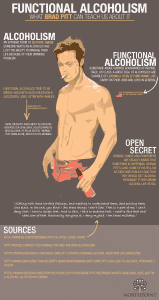When Brad Pitt recently did an interview for GQ magazine, he confirmed that one of the factors that contributed to the demise of his marriage to Angelina Jolie was his drinking. In doing so, he highlights an increasingly-common problem in America – functional alcoholism.
A Golden Public Life and a Dark Private Life
From the outside, Brad Pitt lives an enviable life of fame, fortune, glamour, and accomplishment – he is an award-winning actor, producer, and humanitarian. He is an international sex symbol and is married to one of the most beautiful women in the world, with whom he has a large family. Brad Pitt is Hollywood royalty. But despite the professional accomplishments and public adulation and family man image, it is an open secret in Hollywood that Pitt also LOVES to party. And, as is the case with a lot of people, too much of a good thing eventually became a bad thing. Just like millions of other Americans, golden boy Brad Pitt has a problematic relationship with alcohol. And, as it invariably does when it goes untreated, this problem impacted his life…HARD. After a well-publicized – and evidently alcohol-fueled – altercation between Pitt, his wife, and one of his children, his marriage imploded. 5 days later, Angelina Jolie filed for divorce, with whispers of substance abuse and anger issues swirling about. “…I can’t remember a day since I got out of college when I wasn’t boozing or had a spliff, or something. Something…I mean I stopped everything except boozing when I started my family. But even this last year, you know—things I wasn’t dealing with. I was boozing too much. It’s just become a problem.” ~ Brad Pitt, GQ magazine, May 2017
What is Alcoholism?
 Alcoholism is an extreme form of alcohol abuse. Someone who is an alcoholic has lost the ability to manage their life because of their drinking problem. In the addiction treatment field, alcoholism is often called having an alcohol use disorder, which treatment for alcohol use disorder can help. Alcoholism that continues long-term will eventually result in physical or mental health issues. There are many factors that can contribute to alcoholism, and these are both environmental and genetic. People are more likely to become alcoholics when:
Alcoholism is an extreme form of alcohol abuse. Someone who is an alcoholic has lost the ability to manage their life because of their drinking problem. In the addiction treatment field, alcoholism is often called having an alcohol use disorder, which treatment for alcohol use disorder can help. Alcoholism that continues long-term will eventually result in physical or mental health issues. There are many factors that can contribute to alcoholism, and these are both environmental and genetic. People are more likely to become alcoholics when:
- They have a close relative who is an alcoholic
- They frequently face high-stress situations
- They struggle with anxiety
- They live in a culture where alcohol use is both accepted and encouraged
- They suffer from another mental health condition, such as depression or bipolar disorder
Alcoholism or an alcohol use disorder is diagnosed when an individual:
- Drinks a lot of alcohol over a long period of time
- Is not able to cut down on how much they drink
- Has health issues as a result of alcohol use
- Regularly takes risks after drinking
- Goes through alcohol withdrawal when not drinking
- Needs to drink more alcohol in order to get drunk
It’s important to remember that alcoholism can look different in different people. For many alcoholics, they will binge drink on the weekends. For others, they feel the need to drink alcohol as soon as they wake up in the mornings. Alcoholism is not a condition that can be pinpointed by looking at one or two specific drinking habits. It is more about the results of the alcohol use and how it changes the alcoholic’s life.
“Anyone can have a drinking problem. We can help you get your life back in order. This is our 28-day program.”
Alcohol Use in the U.S.
The use and misuse of alcohol in the United States has never been as prevalent as it is today. In fact, according to the National Institute on Alcohol Abuse and Alcoholism:
- 86.4% of people ages 18 and older reported drinking alcohol at least one time during their lifetimes in 2015.
- More than 70% of them stated that they had consumed alcohol at least once in the last year.
- 56% of them stated that they had consumed alcohol at least once during the last month.
- During that same year, almost 27% of people in that age group reported binge drinking that month.
- 7% admitted to heavy drinking that month.
- In 2015, more than 15 million adults in the United States had an alcohol use disorder.
- Among them, there were 9.8 million men and 5.3 million women.
- That year, only 1.3 million of these individuals received treatment for an alcohol use disorder.
- 88,000 people in the United States die from an alcohol-related cause each year.
- This makes alcoholism the fourth leading preventable cause of death in our country.
The CDC has also weighed in on the problem of alcoholism in the U.S. They state that 25% of adults have had at least one heavy drinking day in the last year. Heavy drinking is equal to five or more drinks for men, and four or more drinks for women. Each year, there are also more than 19,000 deaths due to alcoholic liver disease. More than 30,000 people die from alcohol-induced deaths from accidents, homicides, or other incidents. Alcoholism is a problem, and the statistics couldn’t be clearer. Educating people about alcoholism, functional alcoholism and alcohol abuse is the first step in making a change.
Difference Between Alcoholism and Alcohol Abuse
How do you know if you are abusing alcohol, or someone suffering from alcoholism? It’s common for these two conditions to get confused with each other. They are not the same at all. The main difference is seen in the symptoms of each one. Someone who suffers from alcoholism:
- Needs alcohol to function each day
- Will go through withdrawal once alcohol begins to leave the body
- Periodically needs to increase their alcohol intake due to changing tolerance levels
- Is not able to control how much or how often they drink
- Is not able to stop drinking, no matter how hard they try.
Someone who is participating in alcohol abuse:
- May experience a small amount of alcohol tolerance
- May suffer from slight alcohol withdrawal when not drinking
- May neglect personal responsibilities in favor of drinking more often
- May drink and drive on occasion
- Will drink alcohol as an emotional reaction, or simply to have a good time
- Will periodically drink alcohol in excess
- Doesn’t always feel compelled to drink every day
As you can see, the differences are slight, but they are still there. What’s most concerning is that people tend to believe that they are safe from alcoholism. They feel immune from it, and don’t worry much about drinking abusing alcohol, even if they do it regularly. Research has shown that continued alcohol abuse will eventually result in alcoholism if it’s not stopped. Anyone who abuses alcohol long-term is at risk for becoming an alcoholic, even if they think they’re in control.
What Is Functional Alcoholism?
 Functional alcoholism is a manifestation of an Alcohol Use Disorder that defies the inaccurate stereotype that portrays alcoholics as wildly out of control – perpetually drunk, homeless, dirty, shambling, and confused wrecks. This ignores the fact that 75% of substance abusers have jobs. Addicts and alcoholics are just like everyone else. Even someone who outwardly appears successful, like Brad Pitt – a glamorous job, luxurious homes, a beautiful family, fame and recognition – can struggle with a drug or alcohol problem. Substance abuse ignores boundaries of income, race, or class. Here’s the takeaway – outward success doesn’t matter. Addiction in any form is an incurable disease that worsens over time if it is not treated. And the progressive nature of the disease means there will always eventually be negative consequences—to health, career, or relationships. Functional Alcoholism Is a Real Subtype of Alcohol Use Disorder In 2007, the National Institute on Alcohol Abuse and Alcoholism, part of the National Institutes of Health, identified five distinct “subtypes” of alcohol abusers. This dispels the notion of the “typical alcoholic”.
Functional alcoholism is a manifestation of an Alcohol Use Disorder that defies the inaccurate stereotype that portrays alcoholics as wildly out of control – perpetually drunk, homeless, dirty, shambling, and confused wrecks. This ignores the fact that 75% of substance abusers have jobs. Addicts and alcoholics are just like everyone else. Even someone who outwardly appears successful, like Brad Pitt – a glamorous job, luxurious homes, a beautiful family, fame and recognition – can struggle with a drug or alcohol problem. Substance abuse ignores boundaries of income, race, or class. Here’s the takeaway – outward success doesn’t matter. Addiction in any form is an incurable disease that worsens over time if it is not treated. And the progressive nature of the disease means there will always eventually be negative consequences—to health, career, or relationships. Functional Alcoholism Is a Real Subtype of Alcohol Use Disorder In 2007, the National Institute on Alcohol Abuse and Alcoholism, part of the National Institutes of Health, identified five distinct “subtypes” of alcohol abusers. This dispels the notion of the “typical alcoholic”.
- 19.5% of American alcoholics falls into the “functional” subtype – almost 1 out of every 5.
- Because the NIAAA estimates that there are approximately 17 million US adults with an AUD, that means there are over 3.3 million functional alcoholics in this country.
- Functional alcoholics tend to be/have:
- Middle-aged
- Well-educated
- A good job
- A stable home and family life
- A third of functional alcoholics have a multi-generational family history of alcohol abuse
- A fourth struggle with depression
- About half smoke
Much of this describes Brad Pitt…and about 3 million other men and women.
Signs of Functional Alcoholism
It’s important to get away from the notion that alcoholics are people of low income and limited education. This simply is not true, and functional alcoholism proves it. These are individuals whose lives appear to be just fine from the outside. They may have a lot of friends, have great jobs, and even contribute in positive ways to society. The question is, how can you tell when someone is a functional alcoholic? There are usually some signs you can look for that indicate a problem. Someone who is a high-functioning alcoholic:
- May make frequent jokes about alcoholism
- Have trouble keeping up with responsibilities at home or at work
- Lose important relationships because of their reliance upon alcohol
- May have legal issues, such as a DUI or arrests related to alcohol use
- Feel the need to have alcohol in order to relax or even just to feel normal
- Drink when they’re alone, or first thing in the morning
People who are concerned about being functional alcoholics can also take a quiz to learn more. This quiz will offer even more information about the person’s relationship with alcohol.
Denial Fuels Functional Alcoholism
“…And I’m running from feelings. I’m really, really happy to be done with all of that…it’s been half a year now, which is bittersweet, but I’ve got my feelings in my fingertips again. I think that’s part of the human challenge: You either deny them all of your life or you answer them and evolve.” Functional alcoholics habitually put down any suggestion that they have a drinking problem. As proof, they point to their stability and success. They deny their feelings and struggles and become experts at secretly feeding their alcohol addiction. They make excuses and minimize any cracks in their façade. To outside eyes, they seem perfectly normal. Better, even. Examples of denial include: “I just had a few.” “What’s wrong with blowing off some steam?” “It was just me and the boys having a good time.” “So what if I drink? I show up to work every day.” But here’s the point – chronic substance abuse ALWAYS catches up to a person. One can only drive drunk, sleep it off, endure hangovers, get into violent arguments, and mess in the countless ways that only an alcoholic can so many times before it is time to pay the Piper.
Functional alcoholics habitually put down any suggestion that they have a drinking problem. As proof, they point to their stability and success. They deny their feelings and struggles and become experts at secretly feeding their alcohol addiction. They make excuses and minimize any cracks in their façade. To outside eyes, they seem perfectly normal. Better, even. Examples of denial include: “I just had a few.” “What’s wrong with blowing off some steam?” “It was just me and the boys having a good time.” “So what if I drink? I show up to work every day.” But here’s the point – chronic substance abuse ALWAYS catches up to a person. One can only drive drunk, sleep it off, endure hangovers, get into violent arguments, and mess in the countless ways that only an alcoholic can so many times before it is time to pay the Piper.
It’s Usually an Open Secret
 But despite all the denials, friends, family, and coworkers are usually aware that SOMETHING is going on. Brad Pitt’s case, some of his fellow actors have publicly said that they would get “alcohol poisoning” if they drank alcohol like he did. Another actor said that Pitt “lives on whiskey”. By the time the whispering starts, the AUD is usually fully developed. And, from that point, the disease progresses rapidly – whispering turns to concern. The concern turns to anxiety and fear. Fear causes arguments and unhappiness and depression. Anxiety and depression lead to more drinking – self-medication – in an effort to alleviate the emotional pain. It is a vicious, self-perpetuating dysfunctional cycle. And without professional help, it can be difficult to break free.
But despite all the denials, friends, family, and coworkers are usually aware that SOMETHING is going on. Brad Pitt’s case, some of his fellow actors have publicly said that they would get “alcohol poisoning” if they drank alcohol like he did. Another actor said that Pitt “lives on whiskey”. By the time the whispering starts, the AUD is usually fully developed. And, from that point, the disease progresses rapidly – whispering turns to concern. The concern turns to anxiety and fear. Fear causes arguments and unhappiness and depression. Anxiety and depression lead to more drinking – self-medication – in an effort to alleviate the emotional pain. It is a vicious, self-perpetuating dysfunctional cycle. And without professional help, it can be difficult to break free.
Other Signs of an Alcohol Problem
“I stopped everything except boozing when I started my family. But even this last year, you know—things I wasn’t dealing with. I was boozing too much…It’s just become a problem… I had to step away for a minute. And truthfully, I could drink a Russian under the table with his own vodka. I was a professional. I was good.” An AUD doesn’t exist in a vacuum—even if the person is mostly “maintaining”, other areas of their life will still be affected by their alcohol abuse. Telltale signs of a problem may include:
- ALWAYS needing alcohol to feel sociable or relax
- Using alcohol as an escape
- Drinking alone or in secret
- Commonly drinking more than intended
- Memory loss – “Blackouts”
- Mood swings/Irritability when not drinking
- Ignoring responsibilities
- Missing family obligations
- Social isolation – the drinking becomes more important than friends
- Defensiveness about drinking habits
- Obsessing about drinking
- Unsafe habits – drunk driving, for example
- Aggression
- Domestic violence
- Child abuse
- Legal difficulties – DUIs, public intoxication charges, assault
- Relationship issues – separation, divorce, breakups
- Health problems – hangovers, liver damage, heart disease, etc.
- Emotional disorders – anxiety, depression, PTSD
- Injuries sustained while drinking
- Withdrawal symptoms when alcohol isn’t available
As the alcohol addiction worsens, so will the consequences of use. Functional alcoholism can eventually progress to the late stages of severe alcoholism, with significant impact on the person’s physical and mental health.
Overcoming Alcohol Addiction
While alcoholism is a chronic condition, that doesn’t mean that it can’t be overcome. It can, as long as the individual has the right tools and help. When someone is an alcoholic, that person should not stop drinking abruptly. This is very important because it could result in dangerous withdrawal symptoms. People tend to think of alcohol as being safe because it’s so easily accessible. This in itself actually makes it one of the world’s most dangerous drugs. Professional help is needed in order to recover from alcoholism. This includes:
- Time spent in an alcohol detox center. Alcohol detox helps with the withdrawal symptoms from alcohol use. It also assists in overcoming the physical part of the alcohol addiction.
- Time spent in some type of alcohol rehab center. Some people may benefit from inpatient treatment for alcoholism. This will aid in recovering from the psychological part of the alcohol addiction.
- Counseling for the alcoholic’s family. This will help them understand the nature of the problem and give them the support they need.
- Therapy to assist with understanding the reasons behind the individual’s alcohol abuse and alcoholism.
- Participation in Alcoholics Anonymous, or another type of outpatient alcohol treatment. This ongoing support is essential for continued abstinence from alcohol.
Other Successful People Who Struggled with Alcohol
Not only are functional alcoholics often successful, their addictive personality can allow them to overachieve in a wide variety of fields:
- Buzz Aldrin, astronaut
- Ben Affleck, actor
- Winston Churchill, British Prime Minister
- Truman Capote, author
- Jamie Lee Curtis, actress
- Robert Downey Jr., actor
- Betty Ford, US First Lady
- Yuri Gagarin, Russian cosmonaut, first man in space
- Mel Gibson, actor
- Ulysses Grant, US President
- Ira Hayes, war hero
- Ernest Hemingway, author
- Billie Holiday, singer
- Sir Anthony Hopkins, actor
- Stephen King, author
- Mickey Mantle, baseball player
- Joseph McCarthy, politician
- Jim Morrison, singer
- Franklin Pierce, US President
- Daniel Radcliffe, actor
- Pyotr Tchaikovsky, composer
- Dylan Thomas, poet
- Vincent van Gogh, painter
- Amy Winehouse, singer
- Hank Williams, singer
- Robin Williams, actor
What Can We Learn from Famous Functional Alcoholics?
 The first thing to understand is that substance abuse can happen to ANYONE – even people who are in all other appearances incredibly successful. A person can have everything on the outside and still struggle on the inside. But perhaps the most important thing to remember is that it IS possible to recover from chronic alcohol abuse and live a healthier and happier life in recovery. For example, from the list above, many of those famous people are successfully sober right now:
The first thing to understand is that substance abuse can happen to ANYONE – even people who are in all other appearances incredibly successful. A person can have everything on the outside and still struggle on the inside. But perhaps the most important thing to remember is that it IS possible to recover from chronic alcohol abuse and live a healthier and happier life in recovery. For example, from the list above, many of those famous people are successfully sober right now:
- Ben Affleck, recently completed a 2nd stint in alcohol rehab
- Jamie Lee Curtis, sober since 1999
- Robert Downey Jr., sober since 2003
- Mel Gibson, sober since 2006
- Sir Anthony Hopkins, sober since 1975
- Daniel Radcliffe, alcohol-free since 2010
As for Brad Pitt? “Cranberry juice and fizzy water” is his drink of choice these days. And, showing that he is letting go of some of the stubbornness, ego, and denial that fuels the addiction of so many, he admits that he is in therapy, and loving it. About the experience, he says – “Sitting with those horrible feelings, and needing to understand them, and putting them into place. In the end, you find: I am those things I don’t like. That is a part of me. I can’t deny that. I have to accept that. And in fact, I have to embrace that. I need to face that and take care of that. Because by denying it, I deny myself. I am those mistakes.”
Full Infographic:
Sources:
https://www.gq.com/story/brad-pitt-gq-style-cover-storyhttps://nypost.com/2017/05/10/brad-pitt-and-the-new-alcoholism/https://www.livescience.com/59035-brad-pitt-stopped-drinking-alcohol-addiction-explained.htmlhttps://www.usmagazine.com/celebrity-news/news/drinking-with-brad-pitt-can-lead-to-alcohol-poisoning-2010291https://www.usatoday.com/story/life/people/2017/05/03/brad-pitt-interview-divorce-angelinea-jolie-quitting-alcohol-gq-style/101236092/





